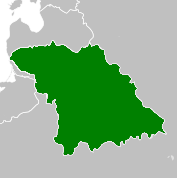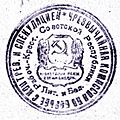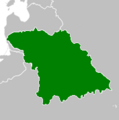Socialist Soviet Republic of Lithuania and Byelorussia facts for kids
Quick facts for kids
Socialist Soviet Republic of Lithuania and Byelorussia
Names in official languages
|
|||||||||||||||||
|---|---|---|---|---|---|---|---|---|---|---|---|---|---|---|---|---|---|
| 1919–1920 | |||||||||||||||||
|
Seal used by the Cheka of Litbel
|
|||||||||||||||||

Map of the areas claimed by SSR Lithuania and Belorussia in 1920 (in Green).
|
|||||||||||||||||
| Status | Unrecognised state | ||||||||||||||||
| Capital | Vilnius Minsk |
||||||||||||||||
| Official languages | Belarusian · Lithuanian · Polish · Russian · Yiddish | ||||||||||||||||
| Government | Socialist soviet republic | ||||||||||||||||
|
• Chairman of the Presidium of the Central Executive Committee of Soviets
|
Kazimierz Cichowski | ||||||||||||||||
|
• Chairman of Council of People's Commissars
|
Vincas Mickevičius-Kapsukas | ||||||||||||||||
| Historical era | Interwar period | ||||||||||||||||
|
• Established
|
27 February 1919 | ||||||||||||||||
|
• Disestablished
|
31 July 1920 | ||||||||||||||||
| Currency | Ruble | ||||||||||||||||
|
|||||||||||||||||
The Socialist Soviet Republic of Lithuania and Byelorussia (often called SSR LiB or simply Litbel) was a short-lived country. It existed for about five months in 1919. This republic was located in parts of what are now Belarus and Lithuania.
Litbel was formed in February 1919. It was created by combining two smaller Soviet republics: the Lithuanian Soviet Socialist Republic and the Socialist Soviet Republic of Byelorussia. Many people saw Litbel as a "puppet state" of Soviet Russia. This means it was controlled by Russia, even if it looked independent. Litbel's government had limited power over the areas it claimed. By August 1919, Litbel had lost all its claimed land. This happened as the Polish and Lithuanian armies advanced.
Contents
History of Litbel
Why Litbel Was Created
After World War I ended in November 1918, Soviet Russia began to expand. It followed the retreating German Army westward. Russia wanted to spread its idea of a "global revolution" and set up Soviet republics in Eastern Europe. By late 1918, Bolshevik (Soviet) forces reached Lithuania. They saw the Baltic states as a way to reach Western Europe. There, they hoped to join other revolutions happening in Germany and Hungary.
The Socialist Soviet Republic of Lithuania was declared on December 16, 1918. The Socialist Soviet Republic of Byelorussia (SSRB) was set up on January 1, 1919. Soviet Russia's leaders decided to combine these two new republics. They also wanted to move some eastern areas from Byelorussia to Soviet Russia.
Uniting Lithuania and Byelorussia
Meetings were held in Minsk (February 1919) and Vilna (Vilnius) (February 1919). At these meetings, leaders discussed the future of the Soviet republics. The idea of uniting Soviet Byelorussia and Soviet Lithuania was strongly supported. This was seen as a way to fight against opposing forces.
The First Congress of Soviets of Lithuania met in Vilna. Delegates agreed to unite the Lithuanian and Byelorussian Soviet republics. They also agreed to join them with the Russian Soviet Republic.
Founding of Litbel
On February 27, 1919, a joint meeting took place in Vilna. Leaders from both Soviet Lithuania and Soviet Byelorussia attended. They created the government for the new united republic. This new country was called the Socialist Soviet Republic of Lithuania and Byelorussia (Litbel).
Vincas Mickevičius-Kapsukas became the head of the government. Vilna was named the capital. However, many government offices were actually in Minsk or Smolensk. When Litbel was founded, the areas it controlled had about 4 million people.
A meeting of the Communist parties from Lithuania and Byelorussia also took place. They decided to combine their parties. They also made a decision about farms. Instead of dividing large farms among peasants, they decided to turn them into state-owned collective farms. This decision made many peasants unhappy.
Moving the Capital
As the Polish army moved closer to Vilna, the Litbel government set up a Defense Council. The situation in Vilna became difficult. Polish people in the area supported the Polish army. The Polish army attacked Vilna from April 17 to 21, 1919.
The Litbel government had to leave Vilna on April 21, 1919. They moved to Dvinsk. Losing their capital made the communist movement in the region feel discouraged. Litbel tried three times to take Vilna back, but failed. On April 28, 1919, the government moved again, this time to Minsk. Minsk became the new capital. However, many government supplies and staff were left behind in Vilna.
Later Stages and Dissolution
In May 1919, Polish forces continued to advance towards Minsk. The Litbel government moved once more, to Bobruisk. On May 30, 1919, Litbel signed a treaty with Soviet Russia. This treaty gave Soviet Russia control over Litbel's military and economic matters.
On June 1, 1919, a "Military-Political Union of Soviet Republics" was announced in Moscow. Litbel was part of this union. The republics agreed to have a single military and unified economic control. On June 7, 1919, Litbel's army officially joined Soviet Russia's armed forces.
By July 1919, Polish forces controlled about 75% of the land Litbel claimed. On July 17, 1919, the Litbel Defense Council was dissolved. The government stopped working on July 19, 1919. Its tasks were taken over by a temporary committee in Minsk.
On August 8, 1919, Polish forces captured Minsk. By August 27, 1919, Litbel had lost control of all its towns. The front line between Polish and Soviet forces became stable by September 1919.
By September 1919, Soviet Russia recognized an independent Lithuania. They offered to make a peace treaty. In July 1920, the Red Army took back Byelorussia from Polish forces. On July 12, 1920, the Soviet–Lithuanian Peace Treaty was signed.
On July 31, 1920, the Byelorussian Soviet Socialist Republic (BSSR) was officially re-established in Minsk. This marked the end of the Socialist Soviet Republic of Lithuania and Byelorussia (Litbel).
How Litbel Was Governed
Litbel was formally a sovereign state, meaning it was supposed to be independent. However, its government had limited real power. Many historians believe it was controlled by Moscow. The government was formed with local politicians, but Moscow often made the key decisions.
The republic had five official languages: Russian, Byelorussian, Lithuanian, Polish, and Yiddish. However, Russian was the main language used in public affairs, especially by the Red Army.
Central Executive Committee
The highest authority in Litbel was the Central Executive Committee of Soviets. It had 100 members, and 91 of them were communists. This committee elected a Presidium, with Kazimierz Cichowski as its chairman.
Government Departments
When Litbel was founded, it created several government departments, called People's Commissariats. These included departments for Foreign Affairs, Internal Affairs, Agriculture, Education, Finance, and Military Affairs. Some of these departments, like Military Affairs, were directly managed by Soviet Russia's departments.
The Council of People's Commissars was like the cabinet of ministers. Vincas Mickevičius-Kapsukas was its chairman and also the Commissar for Foreign Affairs.
Economy of Litbel
Litbel's economy was in a very bad state. Years of war, German occupation, and people moving around had severely damaged factories and farms. There was a famine in the area before the republic was even founded.
To try and restart production, the Litbel government used a policy called "war communism." This meant that all economic activities were taken over by the state. Factories were nationalized (taken by the government).
However, local farmers did not like the government taking their produce. The Communist Party used military forces to seize food from farms to feed the cities. This made the relationship between the government and the farmers even worse. Even with food shortages, Soviet Russia pressured Litbel to send food supplies to them and the Red Army.
Litbel's Army
The army of Litbel was called the Lithuanian-Belorussian Army. It was formed in March 1919. This army fought against Polish and German forces.
In March 1919, the Litbel government ordered that all men aged 18 to 40 had to join the army. They also had to work in production. However, many people resisted this order, and it was hard to fully carry out. Many soldiers deserted (left the army without permission). By June 1919, about 33,000 soldiers had deserted in the Minsk area alone.
On June 9, 1919, the Lithuanian-Byelorussian Army became part of the Red Army of Soviet Russia.
State Symbols
The Litbel government chose a plain red flag to be its merchant and military flag. The republic's coat of arms was similar to Soviet Russia's. It featured a golden hammer and sickle in the rays of the rising sun against a red background. This was surrounded by a wreath of wheat, with the initials 'SSR L and B' written in five languages: Lithuanian, Polish, Yiddish, Russian, and Byelorussian.
Images for kids
See also
 In Spanish: República Socialista Soviética Lituano-Bielorrusa para niños
In Spanish: República Socialista Soviética Lituano-Bielorrusa para niños
- History of Belarus
- History of Lithuania
- Byelorussian Soviet Socialist Republic
- Lithuanian Soviet Socialist Republic (1940–1991)
- Republics of the Soviet Union







